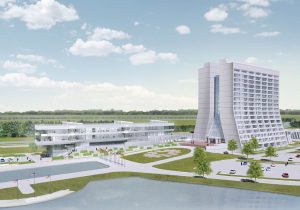Fermilab plans for Integrated Research Center moves closer to reality
Chronicle Media — November 16, 2018
Artist rendering of a conceptual design concept for the Integrated Engineering Research Center.
Plans to build a focal point for Fermilab engineering called the Integrated Engineering Research Center, at the Department of Energy’s Fermi National Accelerator Laboratory have been evolving for the past six years.
Funding has been finalized, design work is under way and construction is now set to start next summer. Construction is likely be completed by the end of 2021.
The project received the remainder of Congressional funding for design and initial construction funding this spring. Fermilab then subcontracted with an architectural firm to begin transforming the building from a concept into a final design.
The new building will be a major addition to the Fermilab site and expand the complex of buildings surrounding Wilson Hall, the center’s 16-story main building.
The center will host existing and international teams of engineers, technicians, and scientists who will further develop Fermilab’s neutrino program and support Fermilab’s upgrade projects for the Large Hadron Collider at CERN.
It will also provide better research and collaborative spaces for research initiatives such as liquid-argon engineering, the design of electronics and ASIC development, and quantum science programs.
“The building will consolidate and centralize people who are currently scattered across the Fermilab site to the central campus area,” said Kate Sienkiewicz, project manager for the IERC. “The idea is to connect the engineers in the IERC and the scientists and projects teams in Wilson Hall to enable collaboration in solving technical challenges. It will provide additional multifunctional space for new initiatives.”
Fermilab officials hope the building be a beacon to attract some of the world’s best and brightest engineers.
“What makes a national laboratory so valuable to the nation isn’t just the scientists,” said Tim Meyer, Fermilab chief operating officer. “It’s the combination of scientists, engineers, technicians, and facilities. This center will be a testament to that synergy. It will create a space for all to join forces and work on the future of particle physics.”
To begin the architectural design process, the project team has been communicating with engineers and scientists to determine space and facilities needs. The goal is to design the building with an eye on adaptability.
Rather than creating many custom spaces, the team is developing different types of spaces to support a variety of scientific requirements. Once space types are determined, designers and architects focus on fitting these spaces together and creating the building’s shape and look.
A main requirement of the design of IERC is to respect and honor the heritage and vision of Wilson Hall and the Fermilab campus.
The project, Meyer said, “indicates a level of support, confidence and enthusiasm between the Department of Energy, Congress and Fermilab, symbolizing the injection of energy and resources into the lab’s future.”
After celebrating 50 years of science and discovery last year, the Fermilab and broader particle physics communities are ready to tackle another half-century of innovation.
“Wilson Hall is iconic, it’s been here for decades and signifies all the great work that we’ve done up to this point,” Sienkiewicz said. “This new building is in some ways a physical representation of the next 50 years of Fermilab. We look forward to a bright future.”



